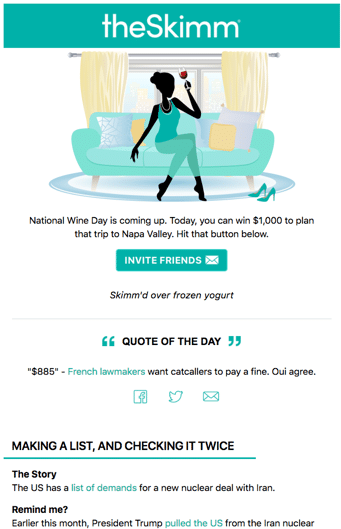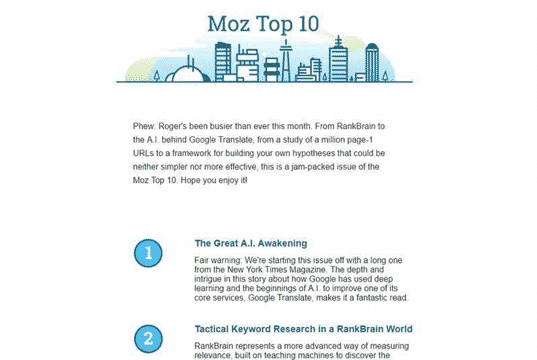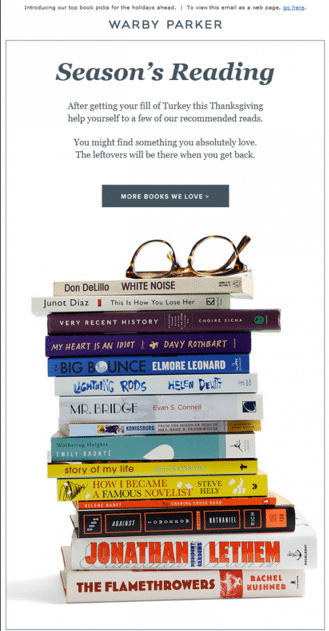Email marketing is one of the tried and true tactics of digital marketing. Newsletters can generate huge returns when you target a loyal audience with great content.
Email has a median ROI of 122% – over 4x higher than other marketing formats including social media, direct mail, and paid search. If you have valuable content to share with your subscribers on a consistent basis, and the time and resources to commit to development, email newsletters are a safe (and smart) bet.
Getting Started: 5 Guiding Questions
1. Why are you doing this? Delivering a quality e newsletter takes time and resources – make sure you have set goals in place to work against to make it all worthwhile. Common goals for e newsletters include: driving sales, boosting engagement, and fostering retention/loyalty.
2. How are you doing this? Gather the resources you need, whether in-house or externally, to plan, write, design, measure, and manage the program. Secure an email marketing tool like MailChimp or Mad Mimi, which will manage your subscriber list, provide reporting, and help ensure that you stay out of spam filters and in-line with regulations and best practices.
3. Who’s getting it? Compile your list and segment it. How is up to you, but some common breakdowns include: demographics, geography, products purchased, frequent buyers, and/or lapsed customers.
4. What’s in it? Gather your content. Common elements include, but aren’t limited to: product info/announcements, tutorials/how-tos, social media posts, news, events, and special promotions.
5. How are you promoting it? Build your list by adding newsletter sign-up buttons to your site, promoting it through social media, and adding it to email signatures.
Email Newsletter Design Tips

Most email marketing platforms have a collection of email templates you can choose from, or, for more branding control, you can opt to design your own HTML template. Whichever you choose, remember these things:
- Less is more. Go for a design that is simple and easy to scan.
- Make sure your newsletter is mobile-friendly/responsive. Think: links and buttons that are easy to click, and short, concise content.
- Use a visual hierarchy for CTAs. Make the primary CTA the most prominent so you can drive the most eyes and clicks there.
- Use a consistent design from email to email. Both from a branding standpoint and for your own sanity, it is best to adapt your content to fit the design rather than vice versa.
- Test your email in different email clients and browsers to make sure it renders properly across the board.
- Take a look at the plain text version, too, since some email clients may not display the HTML properly.
- Make sure you fill out the image alt text – some email clients don’t load images or the users may have images disabled. The image alt text will provide a description to show in place of the image.
- Be sure to include a footer with an address and an unsubscribe option (an email marketing platform will automatically include this for you).
10 Email Newsletter Dos and Don’ts
Stick to one vertical. Many find it tempting to cover every part of their business in one overwhelming newsletter, but a best practice is to develop several different newsletters, each tailored to a specific vertical. This lets your audience cherry pick the topics they’re most interested in, which helps boost newsletter engagement.
2. Give your subscribers options and explain what they’ll get. By letting subscribers choose the topics they’re interested in during the sign up process, you’re guaranteed a more engaged newsletter audience. Be clear about what kind of content they can expect to get, and how often, to minimize the chances of unsubscribes down the road.
3. Lead with your best content. Readers will be scanning, so if there’s something you really want them to see, put it first just in case they lose interest before they reach the end.
4. Be brief. Remember, the goal is to have your readers take an action, like visit your site to read more, or click to download something. You also don’t want to overwhelm them with too much content—if it looks crowded and time consuming, they may not read it at all. Write just enough to entice your reader.
5. Don’t go too hard on product and promotion. The reason people are going to read your newsletter on an ongoing basis is because it’s interesting and offers value beyond discounts and product announcements. The general rule of thumb is 90% educational, 10% promotional.
6. Don’t overwhelm their inbox. Be consistent with your delivery schedule but mindful of your frequency. Have you ever received so many emails that you started ignoring them completely? Don’t be that sender.
7. Get creative with your subject lines. Which would you rather open: “[Company Name] Newsletter for [Date], or “DO NOT make these travel mistakes”? Get more opens by invoking curiosity, giving a sense of urgency, or just by making someone chuckle.
8. Give them something extra. Your subscribers are your fans. Thank them by giving them exclusive offers, sneak peaks, behind-the-scenes access, or whatever else you can think of to make them feel appreciated.
9. Test, test, test. Test subject lines, layouts, CTA placements, time of day, and day of week, to name a few.
10. Don’t spam. It goes without saying, but don’t send someone your newsletter unless the person has opted in.
How to Measure E Newsletter Success

You designed it, wrote it, and sent it. Now what? Well, first, wait a few days to give all the recipients a chance to open and read your newsletter. Then, start measuring engagement. Metrics to look at include: open rate, delivery rate, click through rate, conversions, unsubscribes, list growth, share rate, and ROI.
Open Rate
The average open rate across industries is 32%. You can find specific open rates by industry here. Beware though – open rate tracking isn’t completely accurate because it relies on images. If a recipient’s email client doesn’t load images, then the email won’t be reported as opened.
Click-Through Rate
The average click through rate for email is around 4% – if yours is consistently below that, start investigating why. Is your list segmentation off? Is the newsletter not displaying on mobile correctly? Is the content not resonating?
You may also want to look at the Click to Open Rate (CTOR), which divides total unique clicks by unique opens. This is a better measure of the value of your content, although again, it’s tricky given the unreliable open rate. A standard CTOR is between 20-30%.
Conversions
For conversions, look at any specific CTAs that were in the eNewsletter – was there a special offer promo, or a link to a form? Or were there actions taken on the site after a clickthrough from the newsletter that you can track (like a purchase, or a contact us form completion)? How does the conversion rate compare to other marketing campaigns
Delivery Rate
Delivery rate is the number of emails sent, minus bounces, divided by the number of emails sent. Your email provider should provide you with this metric, and you should aim for a delivery rate of 95% or better. If it’s lower than that, it’s time to do some list clean up.
Unsubscribes
You will always have some unsubscribes with every mailing (the average is less than 0.5%), but if you see an unsubscribe rate of 1% or higher, it may be time to re-evaluate your newsletter in term of your list, design, and/or content. Be careful with this metric, too – many people don’t bother to unsubscribe and choose to just ignore your emails instead. This is why click throughs and conversions are the best metrics for assessing engagement.
List Growth
The more people who subscribe, the more eyes and potential customers you can send to your site. Because of unsubscribes, email address changes, and other factors, your list will shrink over time. To combat this, keep up the growth by regularly promoting your newsletter on your site and in social media, and by making the sign-up process as easy as possible.
Share Rate
If you include share and/or forward buttons in your emails, then you can calculate how often your content is shared, which is a great indicator of the value of what you’re providing. It’s also a great way to improve list growth (see above).
ROI
If your goal for the email newsletter is to drive more revenue, then this is the ultimate measure of success. You’ll need to have the analytics tracking in place to tie all of the pieces together from a visit through to a sale, but if you can connect those dots, you’ve won the metrics game.
Great E Newsletter Examples
Need some inspiration? Here are a few e newsletters that stand out in our collective inboxes:
- theSkimm: This one has it all – punchy subject lines, clear and catchy copy, a mix of serious and fun content, and smart promotion (via their brand partnerships and Skimm’bassador sharing program)

- Moz Top 10: Moz’s newsletter is a great example of selfless thought leadership as a way of maintaining loyalty. They put out content that’s important to their readers, even if it isn’t their own. The end result is highly engaged, long-term subscribers.

- Warby Parker: Warby Parker’s emails are beautifully designed, and so much fun. Yes, they’re selling you glasses, but they’re entertaining you along the way. And educating a little bit, too.

It’s time for email newsletter greatness. If you’ve finished reading this, you know everything you need to go forth and build a brilliant newsletter. Good luck!
Learn more about how to reach the next generation of influential shoppers – Gen Z – by clicking on the button below!






















